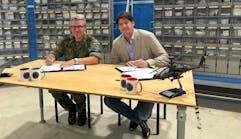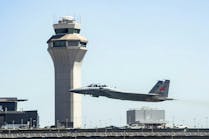(TNS)
Nov. 17—EGLIN AFB — An Eglin Air Force Base unit will become a primary building block of an Air Force effort to boost U.S. capabilities in offensive and defensive electronic warfare, according to the commander of the service's Air Combat Command.
The Air Force effort is, in turn, part of an initiative across the entire Department of Defense to ensure that the United States maintains "military overmatch" against its adversaries in the use and exploitation of the electromagnetic spectrum, according to the DoD's recently released Electromagnetics Spectrum Superiority Strategy.
The electromagnetic spectrum is the electronic arena in which digital and other communications, including data transmission — both military and commercial — are conducted. As noted in the DoD strategy released last month, U.S. capabilities in the spectrum are threatened by both "increased adversary competition and commercial congestion."
The Air Force is planning to stand up a spectrum warfare wing next year, in large part to address U.S. adversaries' gains in the ability to interfere in the electromagnetic spectrum. Those gains place U.S. military and commercial enterprises in increased jeopardy.
Gen. Mark D. Kelly, head of the Air Force's Air Combat Command, recently told Air Force Magazine that the service currently is "working through ... a plan of action and milestones" for the planned new wing.
What is already known about that plan, Kelly told Air Force Magazine, is that "it's going to be significantly built off a lot of our already-organic 53rd Electronic Warfare Group (53rd EWG at Eglin AFB) ... that does a lot of our work across the spectrum ... ." Details of exactly how the 53rd EWG will be integrated into a new spectrum warfare wing are still being finalized, Kelly told the magazine.
As far as the Air Force itself is concerned, recently retired former Vice Chief of Staff Gen. Stephen W. Wilson, who formally left the service just last week, said during an Oct. 30 event live-streamed by the Air Force Association that the Air Force's capabilities within the electromagnetic spectrum "atrophied during the wars in Afghanistan and Iraq, when those capabilities weren't challenged by U.S. enemies," according to a paraphrased report in Air Force Magazine.
Wilson's comments came the day after the DoD released its strategy for gaining superiority in the electromagnetic spectrum.
The 53rd EWG is part of the Eglin-headquartered 53rd Wing. The wing serves as the focal point for the service's combat air forces in electronic warfare, armament, avionics (electronic flight data equipment) and aircrew training devices, among other missions.
Within the 53rd Wing, the 53rd EWG is responsible for providing operational, technical and maintenance electronic warfare expertise for the Air Force's combat air enterprises. The 53rd EWG also has responsibilities for systems engineering, testing, evaluation, tactics development, employment, capability and technology assessment.
Additionally, the 53rd EWG manages the Air Force's Combat Shield, an electronic warfare assessment program for the electronic warfare systems aboard the service's combat aircraft.
There are eight squadrons and two detachments with the 53rd EWG, with a variety of missions including providing electronic warfare expertise and test facilities, testing combat aircraft capabilities against foreign radar systems and developing, testing and fielding mission data to ensure combat capabilities of the F-35 stealth fighter aircraft assigned to the Air Force, Navy and Marines.
The Air Force's efforts in connection with boosting the service's capabilities in and with the electromagnetic spectrum, including whatever role the 53rd EWG will play, will be conducted through the U.S. Air Force Warfare Center at Nellis AFB in Nevada. The USAFWC conducts live and virtual operational test and evaluation and develops tactics to optimize Air Force capabilities.
In the electromagnetic spectrum strategy document issued last month, the Department of Defense notes that the U.S. military currently "is challenged to assure and maintain access, use ... and maneuver within the Electromagnetic Spectrum (EMS) at home and abroad."
That circumstance, the report goes on to say, "jeopardizes the U.S. military's ability to sense, command, control, communicate, test, train, protect, and project force effectively." Failing to achieve and assert superiority within the electromagnetic spectrum means, according to the DoD, that "the nation's economic and national security will be exposed to undue and significant risk."
According to the DoD strategy document, a "roadmap and implementation plan" for achieving the goals of the electromagnetic spectrum superiority strategy should be forthcoming from the department by March of next year.
There had been signs at Eglin AFB earlier than Kelly's recent announcement of the leading role the 53rd EWG will play in spectrum superiority that the installation was beefing up its electronic warfare enterprises.
In July, the 53rd EWG activated the 39th Electronic Warfare Squadron after deactivating a smaller unit, Detachment 1 of the 453rd Electronic Warfare Squadron, declaring it "mission complete."
"This is a great day for the Air Force, our airmen, and the future of spectrum warfare," Lt. Col. Matthew Munska, commander of the 39th Electronic Warfare Squadron, said at July 23 ceremonies marking activation of the new squadron, according to an Eglin AFB news release.
"Deactivating the 453rd EWS, Detachment 1 and reactivating the mission as an independent squadron — the 39th EWS — emphasizes the critical role the unit has in spectrum warfare," Col. Ryan Messer, commander of the 53rd Wing, said at the ceremonies.
The 39th EWS's mission "will enable electronic warfare and electromagnetic spectrum operations today and posture the combat aviation forces for future operations," according to the Eglin news release.
___
(c)2020 the Northwest Florida Daily News (Fort Walton Beach, Fla.)
Visit the Northwest Florida Daily News (Fort Walton Beach, Fla.) at www.nwfdailynews.com
Distributed by Tribune Content Agency, LLC.


